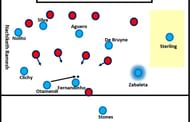Zabaleta and Clichy in half-spaces but maintain width – Half-space overloads
Unlike the previous games, in which the wingbacks were changing to false fullbacks and were moving towards the center circle, Zabaleta and Clichy only moved as central as the half-spaces.
They also maintained width and supported their wingers in the wide zones to achieve 2v1 situations against West Ham’s wingbacks.
Their movement to half-space was purposeful, as the City wingbacks tried to distract and manipulate the movements of the wide players in West Ham’s midfield when the visiting team changed to a 5-4-1 formation. With Zabaleta and Clichy in half-space, the wide midfielders were not doubling up on the wingers as they were aware of the inward runs of City’s wingbacks.
This was creating 1v1 situations in the wings and half-spaces and since most of the City players were better players under such conditions, City was banking on qualitative superiority to overcome such 1v1s and then move on towards the space.

Since Silva and De Bruyne were dropping deeper than usual, City was creating a 3v2 kind of situation in the heart of the midfield. This was allowing Stones and Otamendi to occasionally raid into the opposition half.
Also, City midfielders were able to bypass the middle quite easily to the wings. Here the wingers were gaining the upper hand in 1v1 battles and were thus successfully stretching the defensive line of West Ham. As a result, gaps were being created between the players, which was making it easy enter the box.
When West Ham were pressing in the middle third with quite some ferociousness, situations of numerical and qualitative superiority were helping the play to take place in between the lines. This was probably one of the reasons why West Ham conceded so many fouls.
Sterling and Zabaleta were alternating between the wing and the half-space on the right side of the field. When Sterling was cutting inside during build-ups on the right side, Zabaleta was leaving his half-space position to move wider and maintain balance.
When Sterling was staying very wide during the attacking build-ups on the left side, Zabaleta was holding his position in the half-space in order to force West Ham to play narrow and free up space for his wing partner.

Zabaleta, here, is an extra passing option for Sterling, who is free to receive the pass. Zabaleta is not marked, which makes it even easier as he can run directly through the half-space and pass the ball to his teammates after forcing West Ham to press.
Also, note how Zabaleta’s half-space position is narrowing West Ham. He is allowing Sterling to stay as wide as possible and De Bruyne to be ball oriented.
In the above graphic, if one skips the positioning of rest of the City players, then justice is not being done. It is not just Zabaleta’s position, but it is also the position and the movements of the rest of the players that unlocked more space for Sterling. See that Silva, Aguero, and De Bruyne can all receive the pass.
This only makes West Ham to be over cautious and stay compact on the ball near side. The pass from Otamendi, a half-space to center switch, and the Hammers move closer to Fernandinho and cover his vertical passing options, which again opens the lane to Sterling.
Half-space overloads and switches, which I have explained as one of the ways to beat tight defenses, was a characteristic of Manchester City’s play. The home team was also creating rhombuses with wingback and near side #8 in half-spaces, supported by winger and Fernandinho, to progress the play through the compact space or to further tease the opponents.
